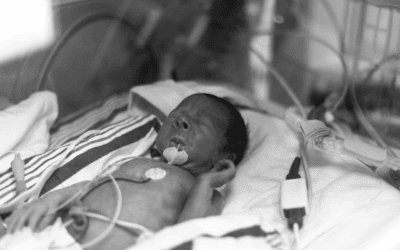Premature birth frequently results in complications for both infants and their families and so continues to be a pressing topic in global neonatal healthcare. While medical advancements have significantly improved outcomes for many preterm babies, simple yet effective interventions like kangaroo care have become vital in neonatal care [1]
Understanding Kangaroo Care
Kangaroo care involves direct skin-to-skin contact between the caregiver and their infant, positioning the baby on the adult’s body, chest-to-chest. This practice, often started shortly after birth and continued until the preterm infant reaches its 40 weeks gestational age [2], creates a warm, nurturing environment that offers numerous benefits centred around the needs of the family.
In the womb, the foetus is surrounded by warmth, darkness, and the maternal heartbeat. The NICU strives to replicate these soothing conditions, though the transition to the clinical setting can be challenging for newborns. Even while maintaining a constant temperature and dimmed lighting, the artificial setting created in the incubator cannot fully replicate the comforting in utero conditions.
Studies have established a scientific foundation for the benefits of kangaroo care, showing that skin-to-skin contact activates specific neural pathways in the brain responsible for regulating stress, temperature, and sleep, and promotes the release of oxytocin, aiding bonding, relaxation, and milk production.
Skin-to-skin care can alleviate some of the stress of the clinical NICU environment for both the preterm infants and their caregivers. However, because these infants are small and fragile, they are often connected to many tubes and wires, making it potentially complicated to provide kangaroo care.
Advantages of Kangaroo Care for Preterm Infants
Kangaroo care offers significant benefits for preterm infants, including reduced mortality, improved physiological stability, better sleep and breastfeeding outcomes, pain relief, and enhanced neurodevelopment, making it a recommended, low-cost intervention for quality infant care worldwide [3]
Research has shown that kangaroo care can significantly lower the risk of mortality in low-birth-weight infants. A meta-analysis revealed that kangaroo care, whether initiated in the hospital or at home, is linked to lower mortality rates during hospitalisation and in the 28 days following birth [4].
In addition, The WHO launched guidelines to improve survival and health outcomes for preterm infants, by initiating skin-to-skin care as soon as possible after clinical stabilisation [5]. The Baby Friendly Initiative also highlights that early and continuous skin-to-skin contact significantly improves survival and health outcomes for preterm and low birth weight infants [6]
- Temperature Regulation: Skin-to-skin contact helps maintain a preterm infant’s body temperature, which is crucial for their survival and development. Preterm infants may need thermoregulation support via medical devices, which often are not designed with kangaroo care in mind. It is important therefore, to use a heat regulation suit which is adapted for this situation, by providing easy access to the infant from the front, without compromising its heat regulation properties.
- Better Breathing: Preterm infants can benefit from the rhythmic movement of a parent’s chest, which helps them regulate their breathing patterns.
- Stress Reduction: The reduction of stress hormones when providing kangaroo care supports better health and developmental progress in preterm infants.
- Increased Weight Gain: Skin-to-skin contact can reduce stress in preterm infants, encouraging improved breastmilk feeding rates, therefore promoting healthy weight gain [7]
- Improved Sleep Patterns: Engaging in kangaroo care offers warmth and security, which can help preterm infants sleep for extended, uninterrupted periods.
- Enhanced Development: The association between providing kangaroo care and improved cognitive [8,9] and motor development in preterm infants is potentially due to the positive sensory and emotional benefits it offers.
- Stronger Bonding: Kangaroo care fosters a deep emotional connection between parents and their preterm infants, laying the foundation for a strong bond.

Weighing the Risks: A Balanced Perspective
While kangaroo care offers numerous benefits, it is important to consider potential risks. In some situations, kangaroo care may not be suitable due to the infant’s condition or the parent’s health. Healthcare professionals must carefully assess each case and provide appropriate guidance.
Potential risks to acknowledge include:
- Infection: It is essential to ensure that caregivers are healthy and free from contagious illnesses before engaging in kangaroo care due to the risk of transmission [10]
- Hypoglycaemia: Preterm infants may be at greater risk of developing hypoglycaemia, and evidence suggests skin-to-skin contact may contribute to a reduction in preterm infants developing hypoglycaemia. Therefore, continued monitoring is still vital throughout the provision of kangaroo care. This includes monitoring for other signs of distress, including bradycardia, desaturation, or apnoea, as well as blood sugar [11]
- Overheating: While kangaroo care helps regulate temperature, it is still possible for the infant to overheat. It is therefore crucial to monitor the infant’s temperature and adjust the environment as needed.
Implementing Kangaroo Care in Healthcare Settings
Healthcare professionals are encouraged to practice the NIDCAP (Newborn Individualized Developmental Care and Assessment Program)[KK1] philosophy [12], providing individualised care to infants, especially preterm infants. This comprehensive, family centred, and evidence-based approach to providing care incorporates Kangaroo Care within its practices.
To maximise the benefits of kangaroo care, healthcare professionals should:
- Educate Parents: Provide comprehensive information about the benefits and techniques of kangaroo care.
- Facilitate Skin-to-Skin Contact: Encourage early and frequent skin-to-skin contact between preterm infants and their parents.
- Support Breastfeeding: Kangaroo care can complement breastfeeding, as the close physical proximity can stimulate milk production and facilitate feeding.
- Address Concerns: Be attentive to parents’ concerns and provide reassurance and support.
- Utilise Supportive Products: Choosing polyurethane (PUR) instead of polyvinyl chloride (PVC) for umbilical catheters allows the dressing to lie flat, which makes kangaroo care easier to facilitate. When using a heat regulation suit, ensure it is specifically adapted for kangaroo care. It should have safe access points for tubes, catheters, and other medical lines, allowing the caregiver to initiate kangaroo care safely and confidently.
Additionally, consider using soft, skin-friendly materials for any interfaces that come into contact with the infant’s skin to reduce irritation and support thermoregulation. Clear labelling and intuitive design features on supportive products can also help caregivers and clinical staff apply them correctly and efficiently, further promoting safe and effective kangaroo care.

Kangaroo care is a simple yet powerful intervention that could significantly improve the outcomes of preterm infants. By incorporating this practice into routine care, healthcare professionals can enhance the well-being of these vulnerable newborns and promote positive parent-infant bonding.
References
[1] Smith ER, Bergelson I, Constantian S, Valsangkar B, Chan GJ. Barriers and enablers of health system adoption of kangaroo mother care: a systematic review of caregiver perspectives. BMC Pediatrics. 2017 Jan 25;17(1).
[2] Li Y, Hu Y, Chen Q, Li X, Tang J, Xu T, et al. Clinical practice guideline for kangaroo mother care in preterm and low birth weight infants. Journal of Evidence-Based Medicine. 2022 Dec;15(4):408–24.
[3] Campbell-Yeo ML, Disher TC, Benoit BL, Johnston CC. Understanding kangaroo care and its benefits to preterm infants. Pediatric Health Med Ther. 2015.
[4] Sivanandan S, Sankar MJ. Kangaroo mother care for preterm or low birth weight infants: a systematic review and meta-analysis. BMJ Global Health 2023;
[5] World Health Organization (WHO). WHO advises immediate skin to skin care for survival of small and preterm babies [Internet]. www.who.int. 2022. Available from: https://www.who.int/news/item/15-11-2022-who-advises-immediate-skin-to-skin-care-for-survival-of-small-and-preterm-babies
[6] UNICEF. Immediate kangaroo mother care post-birth critical for saving lives, new research shows [Internet]. Baby Friendly Initiative. 2021. Available from: https://www.unicef.org.uk/babyfriendly/kangaroo-care-research/
[7] Li J, Wang H, Yang J, Chen X, Cao A, Yang C, et al. Kangaroo mother care enhances exclusive breastmilk feeding and shortens time to achieve full enteral feeding in extremely preterm infants requiring non-invasive assisted ventilation. International Breastfeeding Journal. 2024 Jul 31;19(1).
[8] Lazarus, Molly F. et al. Inpatient Skin-to-skin Care Predicts 12-Month Neurodevelopmental Outcomes in Very Preterm Infants. The Journal of Pediatrics, 2024
[9] Gurgel de Castro Silva M, Carvalho de Moraes Barros M, Maria Lima Pessoa Ú, Guinsburg R. Kangaroo–mother care method and neurobehavior of preterm infants. Early Human Development, 2016
[10] Sivanandan S, Sankar MJ. Kangaroo mother care for preterm or low birth weight infants: a systematic review and meta-analysis. BMJ Global Health [Internet]. 2023 Jun 1;8(6):e010728. Available from: https://gh.bmj.com/content/8/6/e010728
[11] Lord LG, Harding JE, Crowther CA, Lin L. Skin-to-skin contact for the prevention of neonatal hypoglycaemia: a systematic review and meta-analysis. BMC Pregnancy Childbirth. 2023 Oct 21;23(1):744. Available at: https://doi.org/10.1186/s12884-023-06057-8
[12] Model and Impact – NIDCAP [Internet]. NIDCAP. 2024. Available from: https://nidcap.org/about-us/our-work/model-and-impact/


